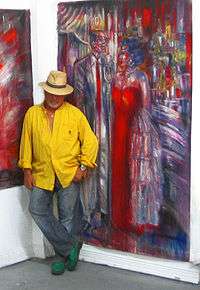Pablo Carreno

Pablo Carreno is an Expressionist artist who was born in 1941 and raised in Havana, Cuba. He emigrated to the United States of America in 1964.
Biography
Pablo Carreno speaks little of his childhood save for his own obsession with drawing and painting. Though his talents were recognized by the age of four, no money was available for formal training, so his early years were spent developing his art through personal experimentation. During that time he also struggled with the changes wrought by the Cuban Revolution, events which forever shaped his perspective and colored his works.
The early 1960s was an especially tumultuous time with the constant political purges of Fidel Castro, the collapse of the economy, and the involvement of the Soviet Union in Cuban affairs. Striking deep at the heart of the country's artists, the new government put superficial emphasis on supporting art, but twisted it into a propaganda tool, selecting artists to promote socialist themes while restricting all other artistic content and commerce.
Chafing under such constraints, Carreno dreamed of emigrating to the United States to gain artistic freedom. With the support and encouragement of his family and a close-knit Cuban community, that dream became a reality in 1964 when he moved to New York. With only high hopes and a few small watercolor paintings in hand, he landed a job illustrating fashion ads for the department store, S. Klein - On The Square. It was a new beginning.
After a few years Carreno became a freelance art director for Spanish Advertising and Marketing Services, the first and, ultimately, the largest agency cited for launching the U.S. Hispanic Madison Avenue advertising era. As a "MadMan", he worked on many marketing campaigns for major companies such as McDonald's and Anheuser-Busch. He also worked on prestigious theatre programs and awards, and was commissioned to do portraits of well known New Yorkers.
Like many artists, Carreno used his commercial skills to support the development of his painting. The expressive quality of his experiences and observations as translated to canvas was both imaginative and emotional, while his exuberance and passion were contagious. From Elston Howard, the first African-American to play for the New York Yankees, to often billionaire Donald Trump, people from all walks of life were drawn to him and his art.
After living in various Manhattan locations, Carreno finally settled in a Greenwich Village studio on the 8th Street block between 5th and 6th Avenues, an area filled with a colorful artistic past. It was a sometime residence for Jack Kerouac, the location of Jimi Hendrix's Electric Lady Studio, and the beginnings of the Whitney Museum.
Little wonder Carreno retains the studio to this day. The rich life of that neighborhood and his Latin American heritage combine to bring a passionate vibrancy to the artist's work. Blending formal elements with charged emotions, Carreno has created his own form of representational expressionism. His works range from expressive figurative to those that border on abstraction.
In an introduction to an exhibition featuring Carreno's art, Peter Tunney, owner of the Time Is Always Now, a SoHo gallery, described the artist and his work:
"Pablo Carreño is a true artist, pure in his abilities and intensely impassioned about the magical place we all exist in. His goal is singular, to achieve a higher art, something none of us know, an elusive and ethereal goal that haunts him every minute of every day. He is consumed by this driving force and has become so in tune, his paintings actually run from his soul and heart, through his fingers and onto his canvas or maybe onto an old piece of cardboard. He can make no mistakes, everything he touches is art of the highest order, including throwing a cup of expresso onto the middle of a beautiful near complete painting!"
Carreno's works also run the gamut in scale and color. He paints monumental canvases reaching twelve feet high, as well as small, intricate drawings, his palette ranging from boldly colored canvases to near-monochromatic studies with a touch of subtle color. This dichotomy of style, while enigmatic, typifies the artist's penchant for setting his own rules.
If pressed, Carreno points to Vincent van Gogh and the Viennese expressionist Oskar Kokoschka among his favorite artists. However, he never views another artist's work as a template to follow. According to Carreno, his brush strokes and visions are an expression of his heritage, tastes, world events, and the people with whom he interacts.
One of his works resulted from a chance meeting with Jerzy Kosinski, author of "The Painted Bird" and "Being There". Carreno was never one to limit his medium and, after a few meetings with the author at Mary Lou's Italian Restaurant, he created a stunning portrait of Kosinski on a set of old blinds.
Similarly, a meeting with the artist Peter Beard led to Carreno's earthy African Series of paintings, while his colorful Jazz and Martini Series were inspired by the recordings of Charlie Parker and evenings at the Blue Note Jazz Club. An unlikely encounter with a member of a Sherlock Holmes Society even inspired the artist to paint two portraits of Victorian illustrator Sidney Paget.
Carreno has garnered professional recognition from many quarters, his paintings residing in collections from California, New York and Miami to Paris, Milan and beyond. He has been represented in numerous one-man and collective shows, sharing the stage with such artists as Viktor IV (Bulgar Finn). His one-man show organized for The Time is Always Now Gallery resulted in an impromptu request for a portrait by business tycoon Sir David Tang.
Carreno continues to paint and as of 2011 he maintains primary residence in Greenwich Village and temporary residence in Miami, Florida.
References
- "Elston and Me: The Story of the first Black Yankee (2001), By Arlene Howard with Ralph Wimbish. Missouri University Press - P. 190.
External links
- http://www.pablocarrenoart.com
- http://www.artisticlicensing.com/pablocarreno.html
- https://www.facebook.com/pablocarrenoart